The Power Of X
A simple yet powerful lighting technique anyone can master in under a minute.
Yes! Send Me My Free Video
Reviewed by Tim Park
![Aputure COB 120t and Amaran M9 Review [VIDEO] Aputure COB 120t and Amaran M9 Review [VIDEO]](https://indiecinemaacademy.com/wp-content/uploads/2016/06/Aputure-120t-M9-header.jpg)
Aputure has done it again with two amazing lights: the tungsten balanced point source Light Storm COB 120t and the daylight balanced “camera mounted LED” Amaran M9. Both have VERY high CRI (Ra)/ CRI (Re) / TLCI / CQS / TM30-15 results, with some of the best R9 (saturated red) values of 160 different LEDs that we’ve tested.
Disclaimer: We are not affiliated in any way to Aputure. From time to time Aputure does send us demos of their products for us to test and review, but beyond that we don’t receive any compensation from them for conducting these reviews.
Some links in this review are part of an affiliate program with Amazon, allowing us to receive a small percentage back. This in no way affects our evaluation of the product or your purchase price, and it helps us offset the time and expense of conducting the reviews and maintaining this site.
All color readings were measured with the Asensetek Lighting Passport in a blacked out studio. For more on CRI (Ra = R1-R8), Extended CRI (Re = R1-R15), the R9 value, CQS, and TLCI, check our article on applying CRI to LEDs. Here is a great article about TM30-15 that explains what fidelity and gamut are and how to read the data.
Aputure Light Storm COB 120t
Price (USD): $645 (Amazon)
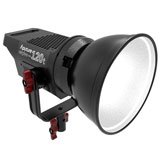 |
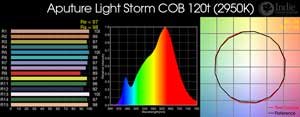 |
|||||
| Color (CCT) | CRI (Ra) | CRI (Re) | TLCI | CQS | Fidelity (Rf) | Gamut (Rg) |
| 2950 | 98 | 97 | 98 | 97 | 96 | 102 |
Aputure Amaran M9
Price (USD): $45
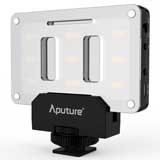 |
 |
|||||
| Color (CCT) | CRI (Ra) | CRI (Re) | TLCI | CQS | Fidelity (Rf) | Gamut (Rg) |
| 5198 | 98 | 97 | 99 | 95 | 95 | 102 |
Aputure Amaran M9 (without diffusion)
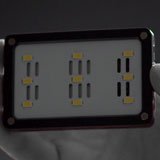 |
 |
|||||
| Color (CCT) | CRI (Ra) | CRI (Re) | TLCI | CQS | Fidelity (Rf) | Gamut (Rg) |
| 5476 | 97 | 96 | 98 | 94 | 93 | 102 |

When LEDs first started being used on set, the color quality left a lot to be desired. However, recently the tech behind LEDs has really taken off and the color quality has improved dramatically, to the point that many large productions are using LEDs exclusively.
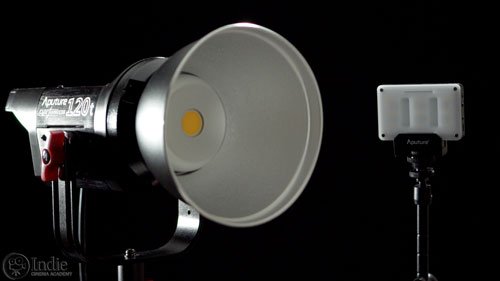
Aputure is one brand that really nails it when it comes to color quality, along with their innovation, build quality, and price. Recently they released two lights that are phenomenal: the Light Storm COB 120t and the Amaran M9. While their uses are very different, they are both worth looking at.
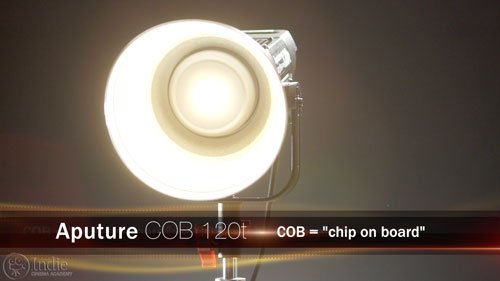
As with all of Aputure’s lights, the COB 120t is solidly built with amazing color quality. It is a point-source light, tungsten balanced at 3000K (CCT: Correlated Color Temperature) with a max brightness that is close to 1.5kW equivalence.

The removable reflector on the front uses a Bowens S-mount, which is an industry standard mount, so you can attach various diffusers such as beauty dishes, umbrellas, soft boxes, and others. It’s easy to use, just flip the switch and turn. To mount, just align the reflector and turn.
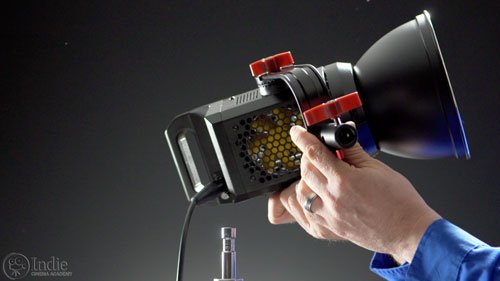
The light easily mounts to any light stand or C-stand and only one knob is necessary to loosen and tighten the light to the yoke when tilting. This along with the light being very lightweight means you can set-up and be lighting your set in no time.

Since all LEDs heat up, especially COB types (“chip on board”), it was important for this light to also have a fan with all the light it’s outputting. Well, Aputure didn’t just add just any fan. They created a fan that is ridiculously quiet. In fact, it is so quiet I didn’t realize there was a fan! Even when I put my ear right up to it, I can barely hear it. As you’ve guessed, a quiet fan is really important when recording audio. The central placement of the fan along with vents throughout the light allows it quickly cool the light.
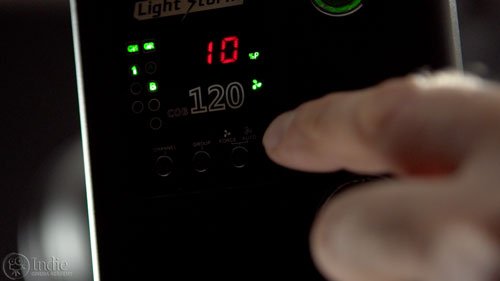
But Aputure didn’t even stop there. They added a feature so that you can select between Auto, meaning the fan turns on and changes speed depending on the need, and change it to Force, which turns the fan on at full power. This might be important when you still REALLY don’t want the fan running while shooting and so you want to turn it on between takes to cool the light as much as possible. Very handy feature.
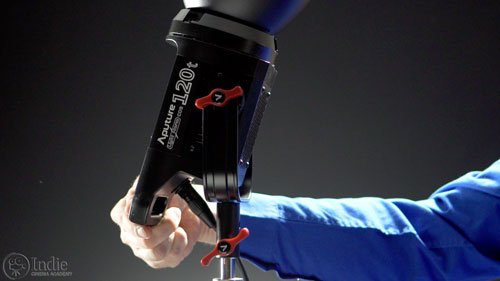
Speaking of handy, many of you who have worked with true tungsten fixtures know all about burning your fingers on the light at some point during the shoot. Well, even though LEDs don’t get hot enough to do the same amount of damage, Aputure still put a nice big handle on the back of the light for easy adjusting.
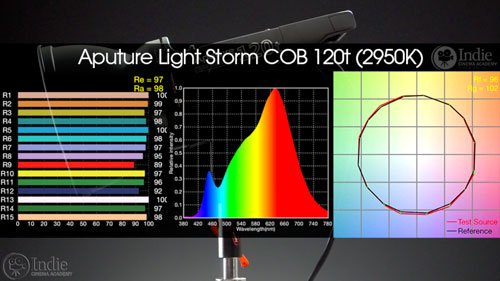
Another shining feature of Aputure lights is their color quality. We’ve said this in previous reviews of Aputure lights, but I’ll point it out again. It’s a brand that consistently puts out products with reliable color quality. We tested the COB 120t with our Asensetek Lighting Passport, and found it to have a CRI (Color Rendering Index) of 98, an extended CRI of 97, a TLCI (Television Lighting Consistency Index) of 98, and a CQS (Color Quality Scale) of 97. Those are not only impressive, but consistent. The spectrum is full with no significant dips. Looking at the TM30-15, the fidelity and gamut indices both look great, with next to no deviation from the test source.
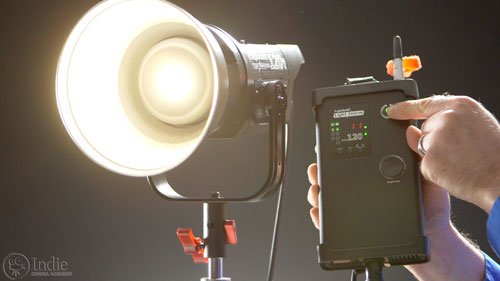
As with most Aputure lights, the COB 120t also comes with a separate dimmable power supply and a remote. How I wish all LEDs controlled the light this way. Many lights mount the dimmer to the back of the light, making it very difficult to adjust the light in most situations. With the wired power controller, you can mount it in a more accessible location. Or you could just use the remote, something we often do from behind the camera when we’re dialing in the look. The extra nice thing about the power controller is that you can mount either a Sony V-mount battery or an Anton Bauer battery on the back for more remote light mounts where it is difficult to plug in.

The M9 is one of those lights that everyone just needs in their kits. Seriously. While this is technically a “camera mounted light,” you really shouldn’t look at it that way. I’ve seen a lot of camera mounted lights, and M9 hardly is in that class.

First off, the color is spectacular. Our measurements show that the light is color balanced to 5200K (CCT), has a CRI of 98, an extended CRI of 97, a TLCI of 99 (YES, 99!), and a CQS of 95. Additionally, the R9 value is an unheard of value of 98! LEDs have a really hard time with R9, which is saturated red, so this is quite an accomplishment. In fact at NAB this year I tested over 160 LEDs, and only four besides the M9 had R9 values of 98…and three of those were tungsten balanced!
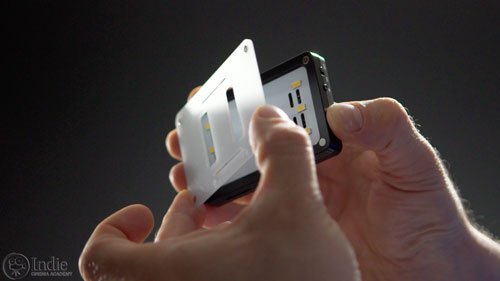
One thing to note, which goes against the advice I normally give about diffusion supplied by the LED manufacturer. With the M9, the diffusion actually makes the color quality even better! Without the diffusion that comes with the M9, the color temp is 5500K, the CRI is 97, the extended CRI is 96, the TLCI is 98, and the CQS is 94. Just a slight change that doesn’t affect anything, but still something I found interesting. So just think of that diffusion as an easy way to warm up the light 300K.

The diffusion is very easy to use since it uses magnets to attach. And it only covers the LED emitters, possibly to reduce weigh or to help keep increase air circulation to reduce heat.

Using the light is easy. There is an on off, and then two buttons to dim the light. There is an internal battery that you can charge up with the supplied USB cable.

Also included is a bottom cold-shoe mount that clamps onto the M9. This means you can attach the light to anything that takes a 1/4″-20 screw. And this is where I find this light to be the most valuable. It is basically one step up from a ribbon light. Ever since my article about how to use ribbon lights, people have been asking if they can build their own panel lights using ribbons. The answer is yes, but with the M9 on the market, why would you want to? These are already hard mounted, have their own power source, and yet are small and inexpensive. And I love how you can very easily use these as accent lights all over your scene.
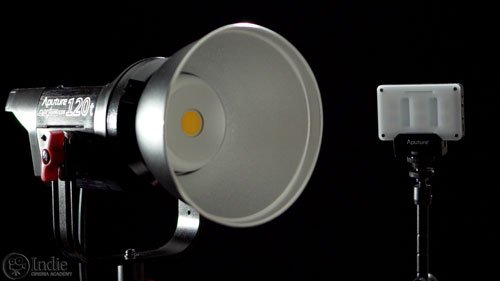
As with all of the Aputure lights I’ve seen and worked with, the COB 120t and Amaran M9 are both smart lights with outstanding color quality. They are a brand of light that I have kept my eye on for the past year, and they continue to amaze me with all of the new products they release.
What do you think about these lights? Have I missed something? Leave a comment and join the discussion!
Here are the more detailed analyses of the color data, for all of you who love the particulars. This data is based off of the complete samplings of the light after it was warmed up, going in increments of 10%. Results were very consistent between all three tests.
(IMPORTANT: the y-axis scale sometimes makes things appear more dramatic than they really are. So keep your eye on all the vertical scales to you don’t jump to the wrong conclusions.)
First off, the actual brightness (measured in lux at 1 meter) compared to the percentage read-out of the power controller is not linear, although consistent. The first 40% is roughly linear and the last 60% is very linear, although together it all feels more like a curve. Not important, since everything should be adjusted by a light meter anyway, or perhaps the waveform. Also the range of brightness at 1 meter is 50 lux to 3650 lux with the reflector mounted. Without the reflector, max is around 2500 lux (not shown).

Next, how the color temperature changes with brightness. Pretty consistent, ranging from 2950K at max brightness to 3070K at 30% brightness, about 120K change over the range. (Some lights have this amount of variation from light to light.)
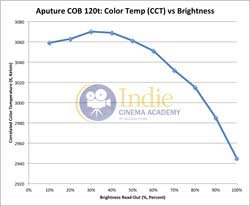
As the light increases form 30% to 100% brightness, the CRI (Ra) values — which is the average of R1 through R8 — decrease from 98.5 to 97.95. Not much, and not bad since 97.95 is still a high quality value! (For a reminder of which colors R1 through R8 are, they are listed in the R-Values vs Brightness section.)
With the extended CRI (Re) — the average of R1 through R15 — the quality drops a tiny amount, from 97.6 at 30% brightness to 96.9 at 100%. Again, fairly small change even though the graph looks dramatic. (The scale is zoomed in significantly.) (The R1 through R15 colors are listed later in this section.)
The peak seen at 30% brightness in CRI (Ra) and CRI (Re) is much smaller with TLCI. Max at 30% brightness is 98.7 and minimum at 100% brightness is 97.4, a decrease of 1.3 TLCI units.
CQS is not as informative since my read-out is only in whole numbers. Yet the trend follows the other measurements, except there is no peak at 30% brightness.
Some of you might be unfamiliar with R-values and which colors are included. So here is a little reminder, which makes it easier to appreciate the graphs later on.
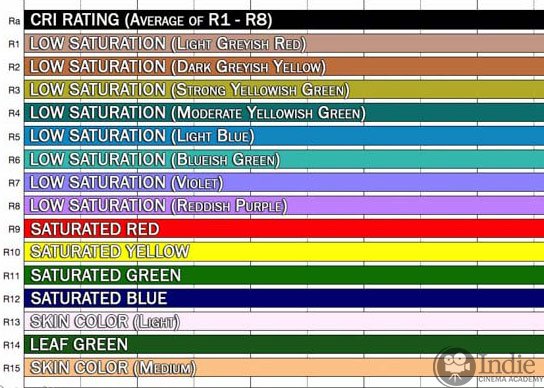
This graph is a bit chaotic so I broke it down in the below graphs. This graph shows how all fifteen R-values change with brightness. Some don’t change much at all, while others change dramatically. This explains the decrease in CRI (Ra) / CRI (Re) / TLCI / CQS numbers as brightness increases. (I’ll save my analysis of this graph for the next two graphs.)
By “Only Flat Values” I’m referring the R-values that don’t change much with brightness. This was done by eye, and I selected those that appeared to change less than 1% from the dimmest to the brightest setting.
By “Only Moving Values” I’m talking about those color values that change significantly over the brightness range. The R8-value and R9-value decrease significantly. R8 changes from 99.6 at 30% brightness to 94.9 at 100%. R9 decreases even more, from 97.7 at 30% down to 88.1 at 100% brightness. Meanwhile the R12-value increases remarkably from 10% to 100% brightness, going from 89.0 at 10% to 92.5 at 100% brightness. What makes this R12 range so incredible is that R12 is a color that LEDs have always had a hard time with. Check out our LED database and you’ll see that most LEDs from 2015 struggled with their R12 values. (In the coming week I’ll be posting the update to the database, which will include over 160 LEDs, most of which I sampled at NAB this year.)
This graph is also a good reminder to be careful with all color readings, be it CRI (Ra), CRI Re, TLCI, CQS, and TM30-15. To encapsulate a very complex spectrum into one or two numbers, a lot of things are averaged together. So even if the final average looks great, there might be big movements within the spectrum that get hidden. R9 is a very important color, since saturated red is important for properly capturing people’s skin tones as well as many of your color produce (strawberries, cherries, apples, tropical fruit, grapes, tomatoes, etc). So if you use the Aputure COB 120t in these situations, you may want to not use the light at full brightness.
 https://indiecinemaacademy.com/wp-content/uploads/2016/01/LED-Ribbon-Title-16x9.jpg
450
800
Tim
https://indiecinemaacademy.com/wp-content/uploads/2013/12/Indie_cinema_Logo_2color-MF-300x116-web.png
Tim2016-01-20 22:02:302019-11-26 08:18:07LED Ribbon Lights: Flexibility In Creating Your Own Light
https://indiecinemaacademy.com/wp-content/uploads/2016/01/LED-Ribbon-Title-16x9.jpg
450
800
Tim
https://indiecinemaacademy.com/wp-content/uploads/2013/12/Indie_cinema_Logo_2color-MF-300x116-web.png
Tim2016-01-20 22:02:302019-11-26 08:18:07LED Ribbon Lights: Flexibility In Creating Your Own Light https://indiecinemaacademy.com/wp-content/uploads/2016/01/LC120-CorporateVideo-Thumbnail-Web.jpg
450
800
Ryan E. Walters
https://indiecinemaacademy.com/wp-content/uploads/2013/12/Indie_cinema_Logo_2color-MF-300x116-web.png
Ryan E. Walters2016-01-11 00:15:082016-05-05 11:22:30How to Cinematically Light a Corporate Video (Cinematic Lighting Lesson 20)
https://indiecinemaacademy.com/wp-content/uploads/2016/01/LC120-CorporateVideo-Thumbnail-Web.jpg
450
800
Ryan E. Walters
https://indiecinemaacademy.com/wp-content/uploads/2013/12/Indie_cinema_Logo_2color-MF-300x116-web.png
Ryan E. Walters2016-01-11 00:15:082016-05-05 11:22:30How to Cinematically Light a Corporate Video (Cinematic Lighting Lesson 20) https://indiecinemaacademy.com/wp-content/uploads/2016/01/AR026-AputureReview-Thumbnail2.jpg
450
800
Ryan E. Walters
https://indiecinemaacademy.com/wp-content/uploads/2013/12/Indie_cinema_Logo_2color-MF-300x116-web.png
Ryan E. Walters2016-01-07 01:10:402018-01-25 10:51:58Aputure LED Light Review: High Quality & Affordable? [VIDEO]
https://indiecinemaacademy.com/wp-content/uploads/2016/01/AR026-AputureReview-Thumbnail2.jpg
450
800
Ryan E. Walters
https://indiecinemaacademy.com/wp-content/uploads/2013/12/Indie_cinema_Logo_2color-MF-300x116-web.png
Ryan E. Walters2016-01-07 01:10:402018-01-25 10:51:58Aputure LED Light Review: High Quality & Affordable? [VIDEO] https://indiecinemaacademy.com/wp-content/uploads/2015/12/LC119-LightFast-Thumbnail.jpg
450
800
Ryan E. Walters
https://indiecinemaacademy.com/wp-content/uploads/2013/12/Indie_cinema_Logo_2color-MF-300x116-web.png
Ryan E. Walters2015-12-29 12:38:562016-01-10 21:42:39How To Light Quickly (Cinematic Lighting Lesson 19)
https://indiecinemaacademy.com/wp-content/uploads/2015/12/LC119-LightFast-Thumbnail.jpg
450
800
Ryan E. Walters
https://indiecinemaacademy.com/wp-content/uploads/2013/12/Indie_cinema_Logo_2color-MF-300x116-web.png
Ryan E. Walters2015-12-29 12:38:562016-01-10 21:42:39How To Light Quickly (Cinematic Lighting Lesson 19)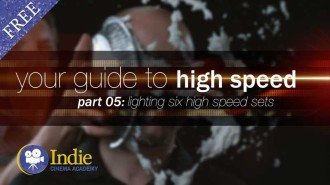 https://indiecinemaacademy.com/wp-content/uploads/2015/12/CS005-HighSpeed-Part05-FREE-Thumbnail-Web.jpg
450
800
Ryan E. Walters
https://indiecinemaacademy.com/wp-content/uploads/2013/12/Indie_cinema_Logo_2color-MF-300x116-web.png
Ryan E. Walters2015-11-30 09:00:282015-12-29 15:41:16Your Guide To High Speed, Part 5: Lighting Six High Speed Sets
https://indiecinemaacademy.com/wp-content/uploads/2015/12/CS005-HighSpeed-Part05-FREE-Thumbnail-Web.jpg
450
800
Ryan E. Walters
https://indiecinemaacademy.com/wp-content/uploads/2013/12/Indie_cinema_Logo_2color-MF-300x116-web.png
Ryan E. Walters2015-11-30 09:00:282015-12-29 15:41:16Your Guide To High Speed, Part 5: Lighting Six High Speed Sets https://indiecinemaacademy.com/wp-content/uploads/2015/12/CS004-HighSpeed-Part04-FREE-Thumbnail-Web.jpg
450
800
Ryan E. Walters
https://indiecinemaacademy.com/wp-content/uploads/2013/12/Indie_cinema_Logo_2color-MF-300x116-web.png
Ryan E. Walters2015-11-16 00:15:182015-12-29 13:17:26Your Guide To High Speed, Part 4: Common Lighting Problems
https://indiecinemaacademy.com/wp-content/uploads/2015/12/CS004-HighSpeed-Part04-FREE-Thumbnail-Web.jpg
450
800
Ryan E. Walters
https://indiecinemaacademy.com/wp-content/uploads/2013/12/Indie_cinema_Logo_2color-MF-300x116-web.png
Ryan E. Walters2015-11-16 00:15:182015-12-29 13:17:26Your Guide To High Speed, Part 4: Common Lighting Problems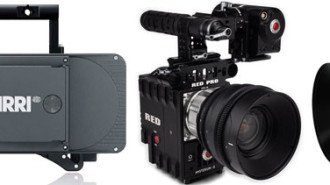 https://indiecinemaacademy.com/wp-content/uploads/2015/11/AlexaEpicBlackmagic-web.jpg
211
800
Ryan E. Walters
https://indiecinemaacademy.com/wp-content/uploads/2013/12/Indie_cinema_Logo_2color-MF-300x116-web.png
Ryan E. Walters2015-11-04 17:53:112018-01-25 10:53:37The Problem With The Digital Camera Look & My Solutions To Correcting It
https://indiecinemaacademy.com/wp-content/uploads/2015/11/AlexaEpicBlackmagic-web.jpg
211
800
Ryan E. Walters
https://indiecinemaacademy.com/wp-content/uploads/2013/12/Indie_cinema_Logo_2color-MF-300x116-web.png
Ryan E. Walters2015-11-04 17:53:112018-01-25 10:53:37The Problem With The Digital Camera Look & My Solutions To Correcting It https://indiecinemaacademy.com/wp-content/uploads/2015/10/HowToLightMeter.jpg
500
800
Ryan E. Walters
https://indiecinemaacademy.com/wp-content/uploads/2013/12/Indie_cinema_Logo_2color-MF-300x116-web.png
Ryan E. Walters2015-10-28 00:15:322018-01-25 10:49:53How To Use A Light Meter: Overview
https://indiecinemaacademy.com/wp-content/uploads/2015/10/HowToLightMeter.jpg
500
800
Ryan E. Walters
https://indiecinemaacademy.com/wp-content/uploads/2013/12/Indie_cinema_Logo_2color-MF-300x116-web.png
Ryan E. Walters2015-10-28 00:15:322018-01-25 10:49:53How To Use A Light Meter: Overview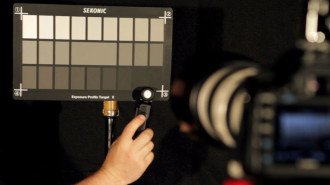 https://indiecinemaacademy.com/wp-content/uploads/2015/10/MetersInDigitalAge-web.jpg
450
800
Ryan E. Walters
https://indiecinemaacademy.com/wp-content/uploads/2013/12/Indie_cinema_Logo_2color-MF-300x116-web.png
Ryan E. Walters2015-10-21 00:15:222018-01-25 10:49:42Why Use A Light Meter In The Digital Video Age?
https://indiecinemaacademy.com/wp-content/uploads/2015/10/MetersInDigitalAge-web.jpg
450
800
Ryan E. Walters
https://indiecinemaacademy.com/wp-content/uploads/2013/12/Indie_cinema_Logo_2color-MF-300x116-web.png
Ryan E. Walters2015-10-21 00:15:222018-01-25 10:49:42Why Use A Light Meter In The Digital Video Age?You must be logged in to post a comment.
This site uses Akismet to reduce spam. Learn how your comment data is processed.
 Understanding the Complete LED Database: Testing Procedures
Understanding the Complete LED Database: Testing ProceduresThis site uses cookies. By continuing to browse the site, you are agreeing to our use of cookies.
AcceptHide notification onlySettingsWe may request cookies to be set on your device. We use cookies to let us know when you visit our websites, how you interact with us, to enrich your user experience, and to customize your relationship with our website.
Click on the different category headings to find out more. You can also change some of your preferences. Note that blocking some types of cookies may impact your experience on our websites and the services we are able to offer.
These cookies are strictly necessary to provide you with services available through our website and to use some of its features.
Because these cookies are strictly necessary to deliver the website, refusing them will have impact how our site functions. You always can block or delete cookies by changing your browser settings and force blocking all cookies on this website. But this will always prompt you to accept/refuse cookies when revisiting our site.
We fully respect if you want to refuse cookies but to avoid asking you again and again kindly allow us to store a cookie for that. You are free to opt out any time or opt in for other cookies to get a better experience. If you refuse cookies we will remove all set cookies in our domain.
We provide you with a list of stored cookies on your computer in our domain so you can check what we stored. Due to security reasons we are not able to show or modify cookies from other domains. You can check these in your browser security settings.
We also use different external services like Google Webfonts, Google Maps, and external Video providers. Since these providers may collect personal data like your IP address we allow you to block them here. Please be aware that this might heavily reduce the functionality and appearance of our site. Changes will take effect once you reload the page.
Google Webfont Settings:
Google Map Settings:
Google reCaptcha Settings:
Vimeo and Youtube video embeds:
You can read about our cookies and privacy settings in detail on our Privacy Policy Page.
Privacy Policy
Thanks Ryan great review.
I am impressed with these lights too.
I would love to get some but I really want daylight balanced.
Do you know if the quality of the light changes when the light is dimmed down?
I would love to know how it compares to the Fotodiox Pro LED100WB
https://www.fotodioxpro.com/led100wb56-studio-led-high-intensity-daylight-led-5600k.html
I’m confused as to comparing the specs on these 2 lights.
The Aputure Light Storm COB 120t is said to be equivalent to 1500W and the specs say it is 2500 LUX at 1m
And the Fotodiox Pro LED100WB is said to be equivalent to 400W and the specs say it is 6400 LUX at 1m
Am I reading this wrong or missing something?
Thanks, Ricky
Great questions Ricky!
I just ran some color quality tests on the 120t and got some results that are the opposite from what I was expecting. I’m going to retest some of them tomorrow to be doubly sure. But it looks like color quality actually gets better as you dim the light. I went up in increments of 10%, from 10% to 100%. The results look like as you increase the brightness the color temp (CCT) goes down 100K, CRI (Ra) goes down 0.5%, CRI (Re) goes down 0.7%, TLCI goes down 1.0%, and CQS goes down 2%. Looking at the R1-R15 values, what is driving this is four values: R8 drops 3.3%, R9 drops 7.5%, R10 drops 2.4%, and R12 goes UP 2.9%. Consider this unofficial…like I said I want to check some things.
As for the max brightness, at 1 meter I’m seeing 4000 lux with the reflector and 2500 lux without the reflector. Meanwhile Fotodiox might be posting their results with the reflector. I don’t have access to that light, so I can’t test it. It does look like the LED 100WB-56 color values aren’t as good as the 120t, although still very good in the big scheme of things. (At some point there’s a point when color is really good enough and we are all just being unnecessarily picky. 😉 )
Hey Ricky,
I created a very detailed analysis of the color quality and other characteristic as the light is dimmed. I posted it in a new tab within the above article. Overall the color quality stays consistent, although as I mentioned in the analysis you may not want to use the light at full power if you are filming anything that has a lot of saturated reds in it, since the R9 values are at their lowest at 100% brightness. (And it’s significantly lower.)
As for your question about brightness, there are a few factors that could be affecting everything. For one, the 120t doesn’t have any lens on the front of the LED. So the light is truly in full flood mode other than what the reflector redirects. Meanwhile the Fotodiox LED100WB (which really is the Lishuai LED100WB, also referred to as the LS LED100WB) has a very large spherical lens covering the LED emitter. Additionally, since the 120t has a Bowens S-Type mount on the front of the light, you can add a fresnel lens and other types of elements to make the light reach farther. All of these things makes it difficult to compare only based on a few numbers posted on a website. Aputure did mention to me they were going to be creating a video explaining the claim to be nearly equivalent to a 1.5kW tungsten, so stay tuned to that on their website and social media platforms. (I’m not affiliated with them at all, so I don’t know any more than what they told me yesterday when I asked for more info.) They are very responsive and really care about their customers, so if you ask them directly I’m sure they will respond.
did you test high frame rates and high shutter speed? did you get flickering? i cant find anything talking about that
I did not check for flickering at high frame rates. I won’t have time to run those tests for a couple weeks, but hope to get those and others soon.
Would absolutely LOVE IT if you guys could please do a test on the Godox SL200w. http://www.godox.com/EN/Products_Continuous_SL100_SL200_Video_Light.html Please!!!!!!!!!!!! They currently claim 95+ CRI. Thanks!
Thanks for bringing this brand of light to our attention. We will contact them to see if we can get a light to test.
Hi!
are u planning to test LUPO LED Fresnel?? especially Lupo DayLED 2000 or 1000, they seem to have a very good quality, but I just not sure the about the r9 reading for DAYLED 2000…
thx!!
We’re testing every LED we can get our hands on and adding them to our LED Database. We tested the Lupo DayLED 1000 while at NAB back in April. Both the R9 and R12 values were low, but it is well known that LEDs struggle with these values. Newer LED tech is vastly improving though, and many lights have very good R9 and R12 numbers.
I have this light but often want it daylight balanced. Would just adding a full CTB gel be the best way? Wondering how it affects the overall CRI and output. thanks
Yes, adding CTB is the best option. It barely affects the CRI, since most gels on the market are specifically formulated to be very accurate in adjusting all wavelengths in the proper proportions to retain quality color rendering. Here’s the downside: since (per watt) tungsten balanced LEDs are much dimmer than daylight balanced LEDs, throwing a CTB gel on a tungsten LED results in much dimmer light. When I figured that out a few years back, I stopped buying tungsten LEDs. It’s a lot better to put CTO on a daylight LED, since it doesn’t decrease the light output as much. I think this is a big reason why companies aren’t producing tungsten-balanced LEDs as much anymore.